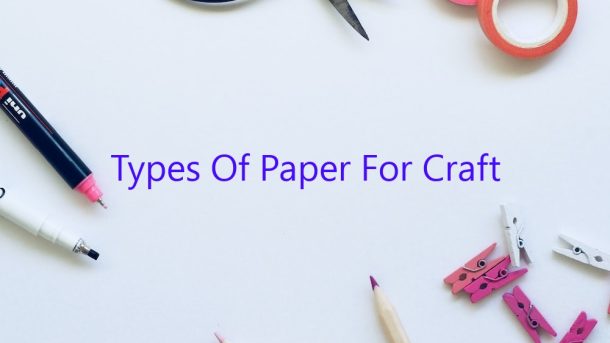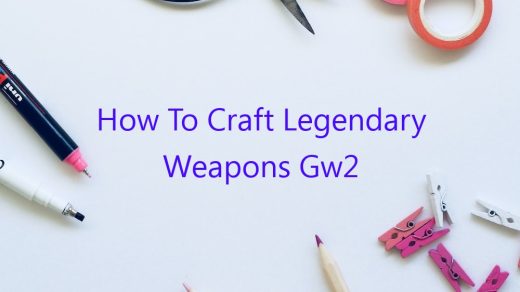There are a variety of types of paper that can be used for crafts. The most important factor to consider is the weight of the paper. The weight of the paper will affect the way the paper handles, how it looks when it is finished, and how long it lasts.
The weight of the paper is measured in pounds per ream. A ream is 500 sheets of paper. The most common weights for paper used for crafts are 20 pounds, 24 pounds, and 28 pounds. Heavier paper is more durable and will last longer, but it is also more difficult to work with.
Another important factor to consider is the type of paper. There are three types of paper: bond, cover, and cardstock. Bond paper is the most common type of paper and is used for printing. It is thin and lightweight and is not very durable. Cover paper is thicker and more durable than bond paper. It is commonly used for printing covers of books and magazines. Cardstock is the thickest and most durable type of paper. It is commonly used for making cards and invitations.
The type of paper that is best for a particular project depends on the project’s requirements. For example, if the project requires a durable paper, then cardstock should be used. If the project requires a lightweight paper, then bond paper should be used.
Contents [hide]
What type of paper is used for crafts?
When it comes to paper crafts, there are a variety of different types of paper that can be used. In general, most crafts use paper that is lightweight and easy to work with. Here is a look at some of the most common types of paper used for crafts:
Construction Paper: Construction paper is a type of paper that is typically used for simple crafts such as coloring or cutting out shapes. It is a relatively inexpensive paper that is available in a variety of colors.
Card Stock: Card stock is a type of paper that is thicker and more durable than construction paper. It is often used for projects that require a more heavyweight paper, such as making cards or invitations.
Craft Paper: Craft paper is a type of paper that is designed specifically for crafting. It is a lightweight paper that is easy to work with and comes in a variety of colors and designs.
Scrapbook Paper: Scrapbook paper is a type of paper that is specifically designed for scrapbooking. It is a heavier paper that is designed to withstand being handled and glued. It comes in a variety of colors, designs, and textures.
Which paper is best for paper crafts?
There are many different types of paper to choose from when crafting. Which paper is best for a particular project depends on the type of project, the weight and texture of the paper, and the desired results.
Some papers are better for certain crafts than others. For example, construction paper is a good choice for projects involving coloring and cutting, while tissue paper is a good choice for projects involving layering and adding details.
The weight and texture of the paper can also affect the outcome of the project. Heavier papers are less likely to fold and crease, while textured papers can add interest and dimension to a project.
Ultimately, the best paper for paper crafts is the paper that best meets the needs of the project. Experiment with different types of paper to see what works best for each individual project.
How many types of craft papers are there?
There are many types of craft papers on the market, and it can be difficult to know which one is right for your project. In this article, we will take a look at the different types of craft papers available, and we will discuss the benefits and drawbacks of each type.
The most common type of craft paper is printer paper. Printer paper is cheap and easy to find, and it is versatile enough to be used for a variety of projects. However, printer paper is not very durable, and it can be torn or creased easily.
Another common type of craft paper is construction paper. Construction paper is thicker and more durable than printer paper, and it is perfect for projects that require a lot of color and texture. However, construction paper is not very versatile, and it can be difficult to fold or cut.
Another popular type of craft paper is scrapbooking paper. Scrapbooking paper is thick and durable, and it comes in a variety of colors and textures. Scrapbooking paper is perfect for creating scrapbooks and other decorative projects.
Finally, there are a few specialty types of craft paper available, including metallic paper, vellum paper, and translucent paper. Metallic paper is perfect for adding a touch of glamour to your projects, vellum paper is perfect for adding a delicate touch, and translucent paper is perfect for adding a touch of mystery.
So, how do you choose the right type of craft paper for your project? It all depends on your needs and preferences. If you need a paper that is versatile and easy to work with, printer paper is a good choice. If you need a paper that is durable and can withstand a lot of wear and tear, construction paper is a good choice. If you are looking for a paper with a lot of color and texture, scrapbooking paper is a good choice. And if you are looking for a unique and special paper, try one of the specialty papers.
What is thin craft paper called?
Craft paper is a thin paper that is often used for crafting projects. It is available in a wide variety of colors and patterns, making it a popular choice for a variety of crafting needs. Craft paper is also thin and lightweight, making it easy to work with.
What is needed for paper crafting?
Paper crafting is a popular hobby that can be enjoyed by people of all ages. It is a great way to relax and express your creativity. In order to get the most out of paper crafting, you will need a few basic supplies.
The most important item you will need for paper crafting is paper. There are many different types of paper available, so you can find one that is perfect for your project. You can also use different colors and textures to create unique effects.
In addition to paper, you will also need scissors, a paper cutter, a ruler, and a glue stick. These basic supplies will allow you to cut and shape your paper, as well as adhere it to other materials.
If you want to add dimension to your projects, you can also use foam squares, wooden shapes, or metal embossing folders. These items can be found at craft stores or online.
Finally, you may also want to invest in a die-cutting machine. This machine allows you to cut shapes out of paper, cardstock, and other materials. Die-cutting machines can be expensive, but they are a great investment if you plan to do a lot of paper crafting.
With these basic supplies, you can create a variety of paper crafts. Have fun experimenting with different materials and techniques, and be sure to share your projects with others in the paper crafting community.
What is thick art paper called?
What is thick art paper called?
Thick art paper is called Bristol paper. It is a heavyweight paper that is acid free and made for printing and drawing.
What is thin paper called?
Thin paper is simply paper that is less thick than the average type of paper. This can be due to a number of reasons, such as the use of less fibers during the manufacturing process or a lesser weight of paper being used. Whatever the reason, thin paper is generally used for specific purposes due to its unique properties.
Perhaps the best-known use of thin paper is in the printing of magazines. Because of the way that magazines are printed – with the pages being fed through the press one at a time – a thinner paper is necessary in order to ensure that the pages don’t get stuck. This is why magazines are generally printed on paper that is around 80 grams per square meter, as opposed to the 120 grams per square meter that is typically used for books.
Another common use of thin paper is in the production of flyers and posters. Again, this is because these items are often printed in large quantities, and a thinner paper is more economical to use. It is also less likely to cause problems with the printing process.
One thing to note is that the term “thin paper” can be a bit misleading, as there is no standard definition of what constitutes a “thin” paper. In some cases, a paper that is considered to be thin might actually be thicker than another paper that is classified as being “regular.” So it’s important to always check the weight of a paper before making any assumptions.




